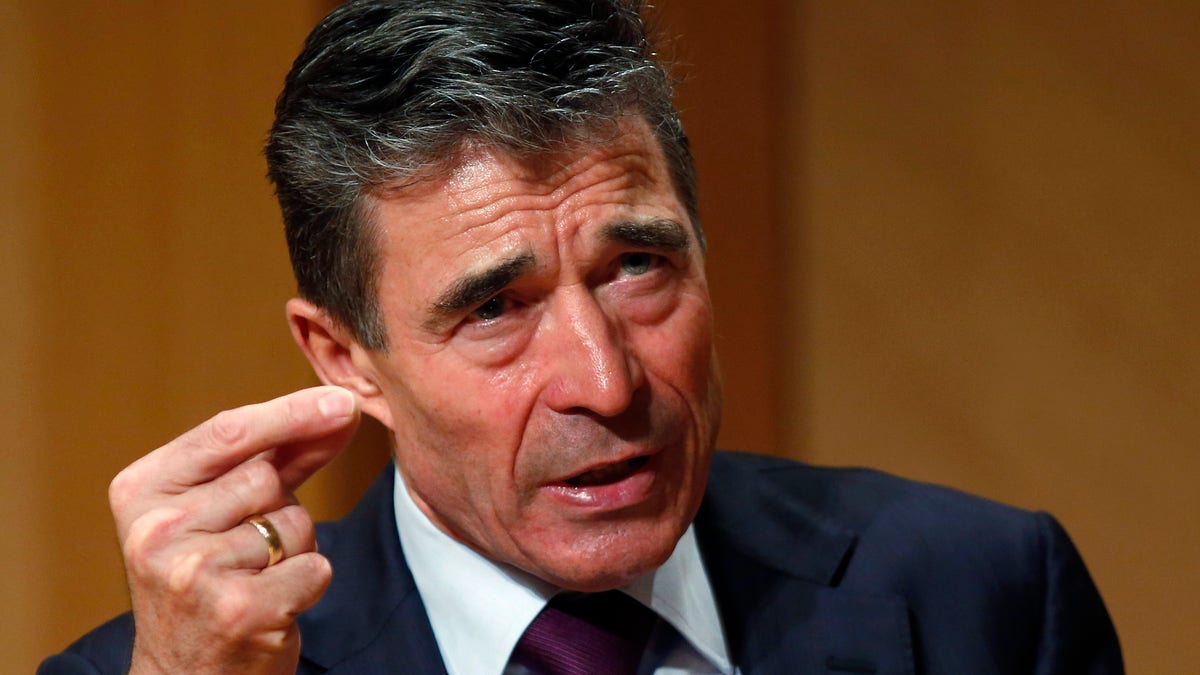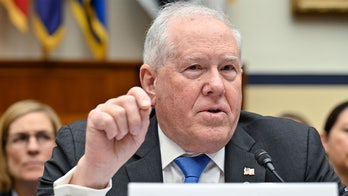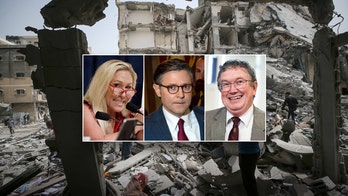
Mar. 19, 2014: NATO Secretary General Anders Fogh Rasmussen gestures while speaking after receiving the Hillary Rodham Clinton Award for Advancing Women in Peace and Security at Georgetown University in Washington. (Reuters)
“This crisis is right on NATO's border,” said Anders Fogh Rasmussen, the secretary general of the North Atlantic Treaty Organization, during a visit to Washington last week, one day after Russia had formally annexed Crimea from Ukrainian control. The Dutch-born politician spoke of NATO's “unique military strength” as a “force multiplier,” one that allows “every ally, even its most powerful one, to pack a bigger punch.”
Yet for all the revived talk of NATO amid the Ukraine crisis, experts see it playing only a modest role – even as an estimated 20,000 Russian troops continue ominous military exercises at the Ukrainian border. It is not a question of manpower so much as a reflection of the alliance’s cumbersome command structure and the consequences of an enduring age of fiscal austerity.
Vice President Biden, visiting Eastern Europe last week, sought to reassure the restive populations of countries not in the Russian orbit by repeatedly invoking Article V of NATO’s charter, which mandates that if one of the alliance’s 28 member states should come under military attack, the rest are obligated to respond with force to counter it. “Our commitment to mutual self-defense under Article V of NATO remains ironclad,” Biden told Polish President Bronislaw Komorowski in Warsaw on March 18. “We will respond,” the vice president reaffirmed in Lithuania the next day, “to any aggression against a NATO ally.”
Poland was among the earliest of the former Soviet satellites to join NATO after the collapse of the Soviet Union, and Lithuania followed suit five years later, in 2004. But after Russian protests in 2008, NATO opted to forgo any attempt at soliciting membership for Ukraine, which recently saw the Russian Federation seize control of Crimea with lightning speed, and presently maintains a contingent of only 6,000 capable soldiers – hardly adequate to repel a broader Russian invasion of the kind many believe Russian President Vladimir Putin to be considering. Thus Biden’s reaffirmations of NATO unity did not, as a formal matter, include the very country at the center of the current crisis.
“Since NATO is a consensus organization, there’d have to be unanimous support for the entry of NATO troops into Ukraine,” said Andrew Kuchins, director of the Russia and Eurasia Program at the Center for Strategic and International Studies in Washington. “So I think that’s pretty much off the table.” Kuchins and others have called, instead, for advanced weapons systems and ammunition to be funneled to the beleaguered interim government in Kiev.
“I frankly think we need to go farther than that, provide some kind of assistance, for example, in monitoring Ukrainian airspace, Ukrainian territory, in the event of incursions, [as well as] certain kinds of weapons that could be effective … addressing Russian weapons in the event that they were to attack,” Kuchins told Fox News.
In fact, interim Ukrainian Prime Minister Arseniy Yatsenyuk has lobbied visiting American officials for such supplies, and NATO could indeed serve as a mechanism for their delivery. But top national security aides to President Obama have already dismissed the idea, saying such supplies would be sufficient neither to change Putin’s calculus nor stave off an actual invasion.
The United States has been sending additional military assets to boost its NATO presence amid the tensions with Russia -- including deploying 300 troops and a dozen F-16 jets to Poland -- as have other U.S. allies. A NATO surveillance plane also was recently deployed to monitor the skies above Ukraine.
Still, while NATO forces participated, most recently, in the U.S.-led war in Afghanistan and in the military operations that toppled strongman Muammar Qaddafi from power in Libya, there are good reasons to question how combat-ready the alliance is. The U.S. – which accounts for more than 70 percent of NATO’s expenditures – has cut its defense spending considerably, with the most recent budget proposals from the Obama administration shrinking active-duty troop strength to the lowest level since World War II.
“I think NATO has been weakened over the years by European members not providing adequately for defense expenditures,” said former U.S. Ambassador to the United Nations John Bolton, now a Fox News contributor. “And I think the United States has failed there, as well.”
Of NATO’s 28 member countries, only four spend in excess of 2 percent of their annual gross domestic product on defense, as NATO recommends.
One proposal has called for NATO to deploy troops to the borders of Kaliningrad, the Russian enclave that is situated between NATO members Poland and Lithuania, and which is home to Russia’s Baltic Fleet. In pure manpower terms, the suggestion is feasible. “NATO shouldn't be taken lightly,” said retired Army Gen. Jack Keane, now a Fox News contributor, on “America’s Newsroom” on March 6. “There are 4 million people under arms. That's not counting the United States. With the United States it's over 5 million. And the fact of the matter is the Russians have 1 million under arms. So at some point, capabilities, quantities, matter.”
But such a maneuver would pose a provocation to Putin far beyond what the Obama administration presently appears willing to entertain. “Our interest,” White House National Security Adviser Susan Rice told reporters on Friday, “is not in seeing the situation escalate and devolve into hot conflict.”




